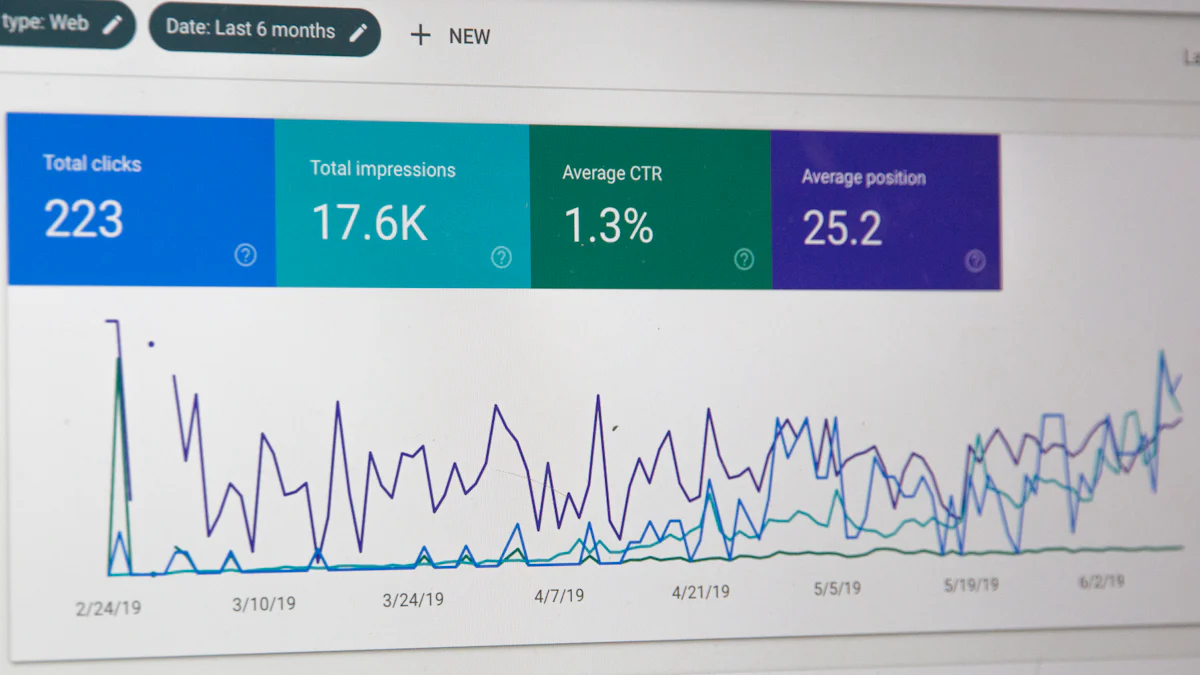


User acquisition involves attracting new customers to a business. Businesses need user acquisition for growth. New users drive sales and increase market presence. Companies face rising customer acquisition costs, with some seeing a nearly 50% increase. Retaining customers costs less than acquiring new ones. However, acquiring new users remains essential. Businesses must focus on effective user acquisition strategies. Successful user acquisition leads to increased profits and sustainability. Companies must prioritize user acquisition to thrive in competitive markets.
Understanding User Acquisition
Definition and Scope of User Acquisition
What is User Acquisition?
User acquisition involves attracting new customers to a business. Businesses use various strategies to engage potential users. Successful user acquisition leads to increased sales and market presence. Companies like Dropbox have effectively used user acquisition strategies. Dropbox quickly acquired a large user base through innovative methods. Businesses must understand the importance of user acquisition for growth.
Scope of User Acquisition in Business
User acquisition plays a vital role in business success. Companies focus on acquiring new users to expand their customer base. This expansion leads to higher revenue and profit margins. Businesses use user acquisition to stand out in competitive markets. Effective user acquisition strategies ensure long-term sustainability. Companies like Groupon have become popular through successful user acquisition. Groupon's deals website showcases the power of strategic user acquisition.
Importance of User Acquisition
Impact on Business Growth
User acquisition directly impacts business growth. New users drive sales and increase market presence. Businesses must prioritize user acquisition to thrive. Companies face rising customer acquisition costs, making effective strategies crucial. Successful user acquisition leads to increased profits and sustainability. Businesses like Airbnb have seen growth through A/B testing. Airbnb's testing resulted in a 2.6% increase in conversions. This demonstrates the importance of data-driven decisions in user acquisition.
Role in Market Expansion
User acquisition plays a key role in market expansion. Businesses use acquisition strategies to enter new markets. Companies like Mobile App Subscription have increased premium users through strategic pricing. Identifying the right pricing strategy ensures high conversion rates. Businesses achieve significant growth through effective user acquisition. A case study showed a 3,072% increase in weekly app installs in five weeks. This highlights the potential of user acquisition in expanding market reach.
Key Strategies for User Acquisition

Organic Strategies for User Acquisition
Content Marketing
Content marketing plays a pivotal role in organic user acquisition. Businesses create valuable and relevant content to attract potential users. Blog posts, videos, and infographics engage audiences effectively. You can build trust and authority by providing informative content. This strategy fosters genuine relationships with users. Content marketing serves as a long-term investment for businesses. Consistent content creation leads to compounding returns over time. Companies like HubSpot have excelled in content marketing. HubSpot's educational resources have attracted a loyal user base.
SEO and Social Media
SEO and social media are essential components of organic user acquisition. Search engine optimization increases visibility on search engines. Optimizing keywords and meta tags enhances website rankings. Social media platforms provide opportunities for user engagement. Businesses share content and interact with users on these platforms. SEO and social media strategies drive cost-effective traffic. These methods contribute to long-term app success and user retention. Implementing best practices ensures higher visibility and reach. Companies like Moz have leveraged SEO for growth. Moz's SEO tools have attracted a wide range of users.
Paid Strategies for User Acquisition
PPC Advertising
PPC advertising offers immediate results in user acquisition. Businesses pay for ads that appear on search engines and websites. You can target specific demographics and interests through PPC. This strategy generates quick traffic and conversions. PPC advertising provides measurable outcomes and ROI. Businesses can adjust campaigns based on performance data. Companies like Amazon utilize PPC for product promotion. Amazon's targeted ads drive significant user engagement.
Influencer Collaborations
Influencer collaborations enhance paid user acquisition efforts. Influencers have established audiences and credibility. Businesses partner with influencers to promote products or services. Influencer endorsements increase brand awareness and trust. This strategy reaches niche markets and specific user segments. Influencer collaborations result in organic lift and retention. Companies like Nike have benefited from influencer partnerships. Nike's collaborations with athletes boost brand visibility.
Techniques for Effective User Acquisition
Target Audience Identification
Market Research
Analyzing competitors provides additional context about market trends. Businesses gain a competitive edge by understanding what users want. Analyzing competitors provides additional context about market trends.
Creating User Personas
Creating user personas enhances user acquisition efforts. These personas represent typical users based on research findings. Businesses craft detailed profiles that include demographics, behaviors, and motivations. User personas guide marketing strategies and content creation. Companies can align products and services with user expectations. This alignment increases engagement and conversion rates. User personas ensure marketing messages resonate with the target audience.
Crafting a Compelling Value Proposition
Unique Selling Points
Unique selling points (USPs) differentiate your business in user acquisition. Identify what sets your product or service apart from competitors. Highlight features or benefits that offer real value to users. A strong USP attracts attention and encourages users to choose your brand. Businesses should focus on clarity and relevance when communicating USPs. Clear messaging ensures users understand the advantages of choosing your product.
Communicating Benefits
Communicating benefits effectively is crucial for user acquisition. Users need to know how your product solves their problems or improves their lives. Use simple language to explain the direct benefits they will experience. Incorporate testimonials or case studies to build trust and credibility. Visuals like infographics or videos can enhance understanding and engagement. Clear communication leads to higher conversion rates and user satisfaction.
User Acquisition vs. User Retention
Definitions and Differences
What is User Retention?
User retention focuses on keeping existing customers engaged with your product or service. Businesses aim to maintain customer loyalty through excellent service and personalized experiences. Retaining users ensures a steady revenue stream and reduces churn rates. Companies often use retention strategies to enhance customer satisfaction and encourage repeat purchases. Successful user retention leads to long-term relationships and brand advocacy.
Comparing Acquisition and Retention
User acquisition and user retention serve distinct purposes in business growth. User acquisition involves attracting new customers to expand the customer base. This strategy boosts market presence and drives initial sales. User retention, on the other hand, focuses on keeping existing customers satisfied and loyal. Retention strategies foster long-term engagement and increase customer lifetime value. Businesses must understand the differences to balance both effectively.
Balancing Both for Business Success
Strategies for Integration
Balancing user acquisition and user retention requires strategic integration. Businesses should align acquisition efforts with retention goals to maximize growth. Companies can use personalized onboarding to enhance user retention. Personalized experiences make users feel valued and encourage continued engagement. Businesses should also leverage customer feedback to improve products and services. This approach ensures that acquisition efforts lead to lasting customer relationships.
- Personalized Onboarding: Tailor the onboarding process to meet individual user needs.
- Customer Feedback: Use feedback to refine products and enhance user satisfaction.
- Cross-Functional Teams: Collaborate across departments to align acquisition and retention strategies.
Case Studies
Case Study: SaaS Company Growth
A SaaS company focused on user retention to drive growth. The company implemented personalized onboarding to enhance user experience. This strategy led to a 5% increase in retention rates. The company saw profits grow by 25% over time. This case study highlights the impact of retention on profitability.
Case Study: Mobile App Success
A mobile app used user acquisition and retention strategies to boost installs. The app achieved a 3,072% increase in weekly installs through targeted campaigns. The app also focused on retention by offering personalized content. This approach resulted in a high retention rate and long-term success.
Measuring User Acquisition Success

Key Metrics to Track
Cost Per Acquisition (CPA)
Cost Per Acquisition (CPA) measures the cost of acquiring a new user. Businesses calculate CPA by dividing total marketing expenses by the number of new users acquired. Lower CPA indicates efficient user acquisition strategies. Monitoring CPA helps businesses optimize marketing budgets. Businesses can identify high-performing channels by analyzing CPA data. Effective strategies reduce CPA and increase profitability.
Customer Lifetime Value (CLV)
Customer Lifetime Value (CLV) estimates the total revenue a user generates over their lifetime. Businesses calculate CLV by multiplying the average purchase value by the purchase frequency and customer lifespan. High CLV signifies valuable user acquisition efforts. Businesses focus on increasing CLV to maximize profits. Understanding CLV helps prioritize retention strategies. Businesses can allocate resources effectively by analyzing CLV.
Tools and Software
Analytics Platforms
Analytics platforms provide insights into user acquisition performance. Businesses use platforms like Google Analytics to track user behavior. These tools offer data on user demographics, traffic sources, and conversion rates. Analytics platforms help identify successful acquisition channels. Businesses can make data-driven decisions by leveraging analytics insights. Continuous monitoring ensures optimized user acquisition strategies.
CRM Systems
CRM systems manage customer relationships and enhance user acquisition efforts. Businesses use CRM software to store user data and track interactions. These systems facilitate personalized communication with users. CRM systems improve user engagement and retention. Businesses can segment users based on behavior and preferences. Effective CRM usage leads to better user acquisition outcomes. Businesses achieve higher satisfaction rates by utilizing CRM insights.
Optimizing User Acquisition Efforts
A/B Testing and Experimentation
Importance of Testing
A/B testing plays a crucial role in optimizing user acquisition strategies. Businesses can compare two versions of a webpage or app feature to determine which one performs better. This method removes guesswork from decision-making processes. Companies can make informed choices that enhance user acquisition efforts. A/B testing validates insights gained from user research. Businesses confirm that findings translate into measurable gains with real customers. Incorporating A/B testing into project budgets ensures resources are allocated effectively.
Examples of Successful Tests
Successful A/B tests have demonstrated significant improvements in user acquisition. A company tested two different landing page designs. The version with a simplified layout increased conversions by 20%. Another business experimented with call-to-action button colors. Changing the button color led to a 15% increase in click-through rates. These examples highlight the potential of A/B testing to drive user acquisition success. Businesses can achieve similar results by conducting well-planned experiments.
Data-driven decision making
Leveraging Analytics
Data-driven decision making enhances user acquisition efforts. Businesses use analytics to gather valuable insights into user behavior. Analytics platforms provide data on traffic sources, user demographics, and conversion rates. Companies can identify high-performing channels and optimize marketing strategies. Leveraging analytics ensures that user acquisition efforts align with business goals. Businesses can make informed decisions that maximize return on investment.
Continuous Improvement
Continuous improvement is essential for successful user acquisition. Businesses must regularly evaluate and refine their strategies. Analyzing data helps identify areas for enhancement. Companies can implement changes based on insights gained from analytics. This approach fosters a culture of innovation and adaptability. Businesses that prioritize continuous improvement achieve sustained growth in user acquisition. Regularly updating strategies ensures that companies remain competitive in dynamic markets.
Common Challenges in User Acquisition
Overcoming High Competition
Differentiation Strategies
Businesses face fierce competition in user acquisition. You must stand out to attract new users. Differentiation strategies help you achieve this goal. Highlight unique features of your product or service. Showcase benefits that competitors cannot offer. A strong brand identity captures attention. Consistent messaging reinforces your brand's uniqueness. You can use storytelling to connect emotionally with users. Stories make your brand memorable and relatable.
Pro Tip: Consider using A/B testing to refine differentiation strategies. Company C tested different discount offers. A limited-time 15% discount increased new customer acquisition by 50%.
Niche Targeting
Niche targeting offers a focused approach to user acquisition. Identify specific segments within your target market. Tailor marketing efforts to meet their unique needs. Niche markets often have less competition. You can achieve higher conversion rates by addressing specific pain points. Personalized content resonates with niche audiences. Use data analytics to identify and understand these segments. Niche targeting builds strong relationships with users.
Budget Constraints
Cost-Effective Methods
Budget constraints challenge user acquisition efforts. Cost-effective methods maximize your resources. Content marketing offers a low-cost way to attract users. Create valuable content that engages and informs your audience. Social media platforms provide cost-effective advertising options. You can reach a broad audience without breaking the bank. Referral programs incentivize existing customers to bring in new users. This approach reduces acquisition costs while increasing loyalty.
Case Study: A company in the connectors industry implemented a referral program. This strategy attracted new customers and strengthened loyalty.
Prioritizing Efforts
Prioritizing efforts ensures efficient use of limited budgets. Focus on high-impact strategies that deliver results. Analyze data to identify top-performing channels. Allocate resources to these channels for maximum ROI. Personalized email marketing campaigns boost engagement and conversion rates. You can tailor messages to individual user preferences. Continuous evaluation helps refine your approach. Adjust strategies based on performance data to optimize outcomes.
Example: A connector company used personalized email marketing campaigns. The result was a boost in customer engagement and conversion rates.
User acquisition drives business growth. Effective strategies attract new users and boost revenue. Businesses must prioritize user acquisition to thrive in competitive markets. Key techniques include content marketing, SEO, and influencer collaborations. Data-driven approaches enhance decision-making and optimize outcomes. Businesses should evaluate current strategies for improvement. A strong focus on user acquisition ensures long-term success. Prioritizing these efforts leads to increased market presence and profitability.
FAQ
User acquisition involves attracting new customers to your business. Effective strategies increase sales and market presence.
User acquisition drives growth and expands your customer base. New users boost revenue and enhance brand visibility.
Content marketing and SEO attract users without paid advertising. Valuable content and optimized websites engage potential customers.
PPC advertising and influencer collaborations offer targeted approaches. These methods provide measurable results and quick engagement.
Market research and user personas help understand potential users. Tailored strategies address specific needs and preferences.
Track metrics like Cost Per Acquisition (CPA) and Customer Lifetime Value (CLV). These indicators reveal the effectiveness of your strategies.
High competition and budget constraints pose challenges. Differentiation and cost-effective methods help overcome these obstacles.
A/B testing and data-driven decisions refine strategies. Continuous improvement ensures sustained growth and competitive advantage.
User acquisition focuses on gaining new customers. Retention keeps existing users engaged and loyal, enhancing long-term value.
Continue Reading About User Acquisition
10 Game-Changing Project Management Reporting Types!
Unlock project success with 10 must-know reporting types! Track progress, manage risks, and stay on budget like a pro.
Lewis
Mar 03, 2025
15 Best Software Reporting Tools for 2025
Explore the top 15 software reporting tools for 2025. Compare features, pricing, and usability to find the best fit for your business needs.
Lewis
Oct 08, 2024
10 Must-Have Marketing Agency Reporting Tools for Your Success
Optimize your agency's performance with top reporting tools. Explore analytics, social media, SEO, and more for data-driven decisions and efficiency.
Lewis
Oct 09, 2024
2025 Best Data Integration Solutions and Selection Guide
Explore top data integration solutions for 2025, enhancing data management and operational efficiency with leading platforms like Fivetran and Talend.
Howard
Dec 19, 2024
2025's Best Data Validation Tools: Top 7 Picks
Explore the top 7 data validation tools of 2025, featuring key features, benefits, user experiences, and pricing to ensure accurate and reliable data.
Howard
Aug 09, 2024
Augmented Analytics: Unlock the Core Concepts & Benefits!
Discover augmented analytics—where AI and ML automate data prep and insights, revolutionizing decision-making for smarter, faster business strategies!
Lewis
Mar 04, 2025


